7+ SAMPLE Sports Crisis Communication Plan
-
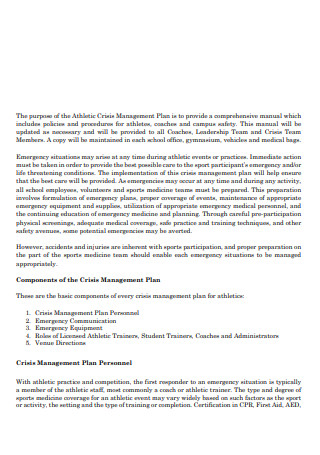
Athletics and Sports Crisis Communication Plan
download now -
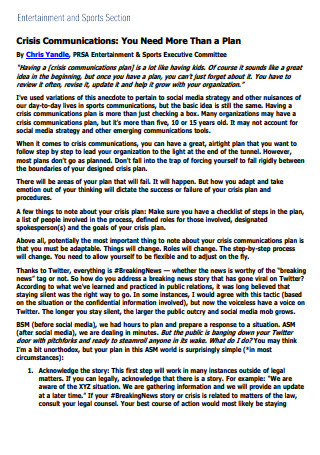
Sample Sports Crisis Communication Plan
download now -
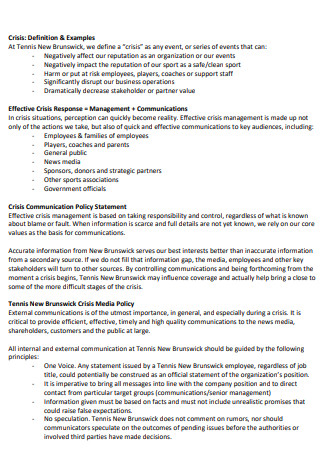
Tennis Crisis Communication Plan
download now -
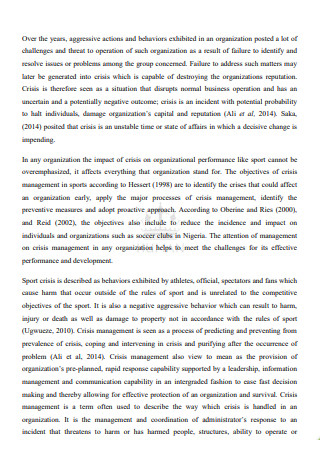
Simple Sports Crisis Communication Plan
download now -
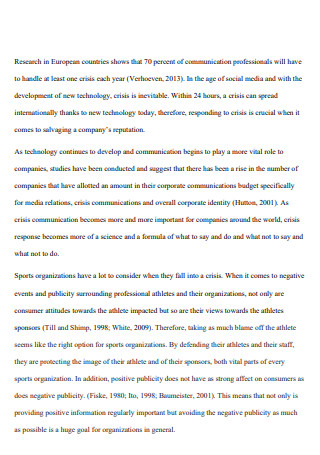
Sports Situational Crisis Communication Plan
download now -
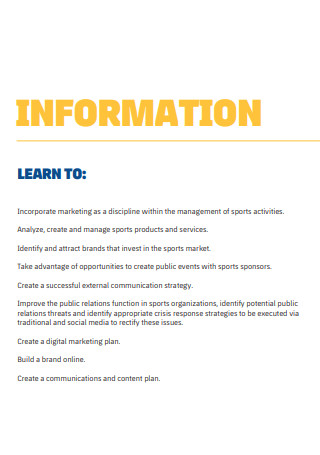
Sports Marketing Sponsorship Crisis Communication Plan
download now -
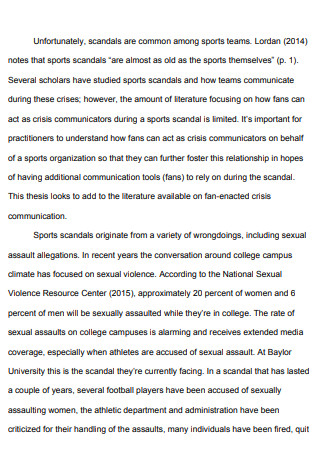
Basic Sports Crisis Communication Plan
download now -

Football Crisis Communication Plan
download now
FREE Sports Crisis Communication Plan s to Download
7+ SAMPLE Sports Crisis Communication Plan
What Is Sports Crisis Communication Plan?
What Is Crisis Communication?
Types of Crisis Scenario
Crisis Communication Strategies:
How to Write a Crisis Communication Plan:
FAQs
What Makes Crisis Communication Effective?
Why Is Communication Important in a Crisis?
What Is Crisis Communication Explain in Detail?
Why is this plan very important? Miscommunication, a tainted image and reputation and mistrust would be some of the after effects if such crisis are not handled properly. This is why planning for a crisis is the only logical way to do if you do not want bigger problems to emerge. Read more about the sports crisis communication plan in this article and to start creating one, you may check out the free sports crisis communication plan samples as well.
What Is Sports Crisis Communication Plan?
A sports crisis communication plan is a set of guidelines used to prepare a anyone for an emergency or unexpected event. This plan includes steps to take when a crisis first emerges, how to communicate with the public, and how to prevent the issue from occurring again. Crisis communication plans focus on the organization’s response and how it will communicate a crisis to its stakeholders. These steps make sure information reaches employees, partners, customers, media, the general public, and any other valuable stakeholders.
Most importantly, a sports crisis communication plan helps guarantee a quick release of information, as well as a consistent message on all company platforms during a time of crisis. That message depends largely on what the crisis involves and how all parties are affected by it.
What Is Crisis Communication?
Crisis communication refers to the dissemination of information by an organization to address a crisis that impacts customers and/or the organization’s reputation. The idea is that a company’s reputation is perceived by everyone who’s aware of your company whether you manage your reputation or not. So, it is in a company’s best interest to have some input about the narrative. Not only that, but customer satisfaction increases when expectations are transparent. While crisis communication can be fairly reactive, it helps to have a crisis communication plan in place before you need to use it to make the process easier on your team members.
Types of Crisis Scenario
Just about any scenario could manifest as a business crisis that warrants communication from your organization. Some of the most common types of crises include:
In addition, anything else you can think of that could stall or halt business continuity is a good example of a crisis that warrants communication with customers and/or the public. While your communication plan will differ depending on the crisis you are dealing with, below are some crisis communication strategies that businesses use to deliver an effective response.
Crisis Communication Strategies:
1. Spokesperson Response
When your company makes a mistake, the best thing you can do is to apologize and be human. The most effective way to do that is to assign a spokesperson to speak on your brand’s behalf. After all, it is a lot easier to relate to one person than a group of lawyers. This person could be your CEO, a company executive, or someone you feel is best suited to represent your company. It is important to choose a good communicator as their actions will influence how your key stakeholders will react to the situation. If they can make your company look human and your mistakes appear manageable, that will play a major role in maintaining stakeholder support.
2. Proactive Damage Control
No matter if things are going well now, you should always prepare for a crisis to occur. Do not worry, this does not make you a pessimist. Instead, it makes you proactive. Proactive damage control is what you do to reduce or prevent the effects of a crisis before it occurs. For instance, adding security software that records and backs up company data will help you avoid a malware crisis. Additionally, you can train your employees to watch out for suspicious or harmful emails that might reach their inboxes.
3. Case Escalation
Sometimes crises can be resolved on the individual level before they reach a viral tipping point. For these cases, it helps to create an escalation system within your customer service team that can diffuse the issue before it gets out of hand.
4. Social Media Response
Social media is a wonderful marketing tool that allows companies to reach audiences across the globe. However, this reach works both ways, as customers can share stories, post pictures, and upload videos for the world to see. One viral video painting your company in the wrong light can lead to millions of people developing a negative perception of your brand. Moreover, crises are battled both in-person and online. So, your company needs a social media plan that can manage the digital buzz around your business. This may include assigning more reps to monitor your social channels or updating followers with new information. But, regardless of how you use it, social media can’t be ignored when your company is working through a crisis.
5. Customer Feedback Collection and Analysis
Sometimes you may have a crisis occurring, but it is not on the front page of the news or going viral on social media. Instead, it is silently affecting your customers and causing churn, but you’re unaware of it because you’re not gathering enough feedback from your customers.
Gathering feedback is an excellent way to prevent a crisis. That is because it provides insight into how customers are feeling about your business. This allows you to spot major roadblocks before they escalate into a crisis. And, it allows customers to share negative criticism that you can use to improve other customers’ experiences.
When faced with an unhappy or escalated customer, our success team recognizes this as a chance to collect customer feedback. They begin interactions by asking customers to review their experience and discuss any unsatisfactory elements. This helps our team create actionable steps that they can use to align themselves with the customer’s needs.
How to Write a Crisis Communication Plan:
Step 1: Identify the Goal of the Plan
Before you begin, your team should determine what the objective of the plan is. It can be as simple as: “This plan creates a structure for communicating with internal and external stakeholders, in the event of a crisis that affects the reputation or normal business functions of the organization.” This ensures every aspect of your plan aligns with this common goal.
Step 2: Identify Stakeholders
When writing the plan, it is important to know who the plan is designed for. Outline a list of all stakeholders you would want to keep informed about the crisis. This list probably includes employees, customers and users, partners, investors, media outlets, the government, and the general public. The latter likely includes social media followers or people located nearby in the event of a location-based crisis. You should also add all necessary contact information for each of these groups in your plan.
Step 3: Create a Hierarchy for Sharing Information on the Crisis
The person or team that reports a crisis does not always handle crisis communications. So, a part of the plan should be dedicated to forming a hierarchy outlining how information should be shared within the company. That way, no matter who notices the crisis emerging, they will know whom to go to first. This order depends on the structure of your team. The first step may be to notify the CEO or president of the organization, followed by the head of communications or public relations. The plan should also constitute what information should immediately be disclosed to these parties. This might include known details about the crisis, the source of the incident, and any existing backlash
Step 4: Assign People to Create Fact Sheets
Your plan should detail which people on the team are in charge of creating fact sheets about the crisis. Fact sheets are lists of known facts about the crisis. They prevent rumors or misinterpretations from spreading to media outlets. Additionally, you should set a deadline for when these fact sheets will be prepared. Depending on the crisis, you may need them within 24 hours, six hours, or even 30 minutes.
Step 5: Identify and Assess Example Crisis Scenarios
When a crisis does happen, you will likely feel overwhelmed. Your mind will race and you will feel pressured to respond to phone calls, social media mentions, and media inquiries. This is why it is best to outline common scenarios in advance. Some types of crises that may affect your organization are natural disasters, disruptions in normal business functions, customer or employee injuries, and product tampering.
Step 6: Identify and Answer Common Questions
During any crisis (no matter how big or small), people are going to ask questions. Whether they are customer advocates or reporters, the public will want to uncover the truth. After all, in most cases, companies are seen as guilty until proven innocent. Crisis communication plans can help you identify and answer questions that you can expect to be asked during your crisis scenarios. For instance, if a natural disaster strikes your headquarters, some questions you may get asked are, “Was anyone injured in the incident?” and “How long will it take for the business to return to normal functionality?”
Step 7: Identify Potential Risks
No matter how well-thought-out your crisis communication plan is, there are always going to be pros and cons. Naturally, you will stick with the plan that maximizes benefits while minimizing costs. However, the costs are still important to consider. Under each plan, you should list out the potential risks you will face. That way, if the plan does backfire, you won’t be caught off guard. You will have prepared yourself and aid out steps for recuperating from these additional losses.
Step 8: Create Guidelines Specific to Social Media
Proactive communication is essential during a crisis. To offer as much transparency as possible, teams should focus on preparing press materials and sharing information about the crisis. The more information you retain, the more the public will want to know what you are hiding.
Reactive communication is just as important. Team members must be focused on social monitoring during a time of crisis. Any negative social media mentions should be dealt with immediately and with consistency. There should be sections of your plan dedicated solely to social media crisis management.
FAQs
What Makes Crisis Communication Effective?
It is important to be prepared, honest and responsive. Crisis communication can be challenging. Provide constant updates to your audience via multiple channels, effectively using social media as a communication tool. After the crisis settles, evaluate your crisis-time performance, and follow up with your audience.
Why Is Communication Important in a Crisis?
Communication is foundational to crisis management. It provides clarity and direction for employees, customers and partners in an otherwise uncertain and confusing time.
What Is Crisis Communication Explain in Detail?
Crisis communication can be defined broadly as the collection, processing, and dissemination of information required to address a crisis situation. It is basically the dialog between the organization and its public(s) prior to, during, and after the negative occurrence.
How well an organization prepares its crisis communication strategies impacts how well it can navigate an actual crisis. The key role of sports crisis communication plan during a crisis is to stabilize and advance the organization by inspiring confidence, earning trust, and engaging stakeholders. Clear, consistent communication is highly valuable to successfully maintain business continuity and recover. The role of strategic communication is to lay the groundwork necessary for organizations to respond effectively and sustain trust. This phase happens before a crisis when a company proactively identifies high-likelihood crisis scenarios and develops plans for managing them.
The crisis communication plan created during this phase should define the dedicated response teams with clear roles and communication responsibilities. It should include an internal and external stakeholder inventory with each audience’s preferred communication channels. Leaders should receive communication coaching during this phase to learn how to respond clearly, authentically and transparently to future crises. Creating templated communication materials for these channels allows organizations to quickly customize and deploy communications if a crisis strikes.
